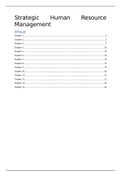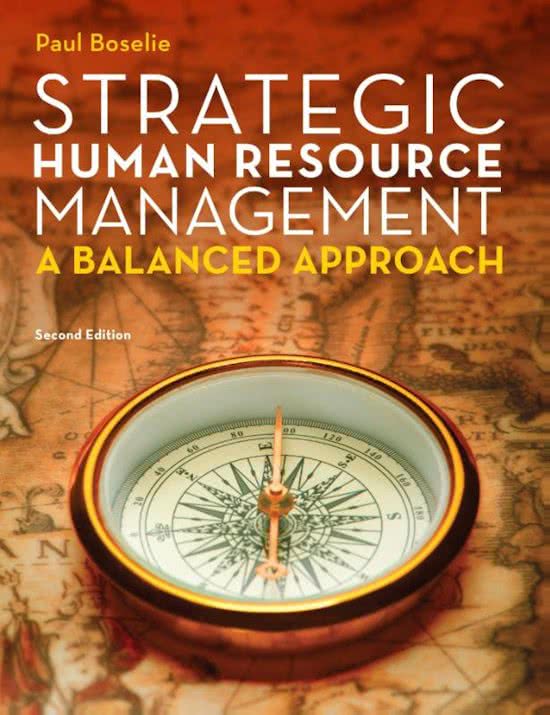Strategic Human Resource
Management
Inhoud
Chapter 1................................................................................................................................................2
Chapter 2................................................................................................................................................3
Chapter 3................................................................................................................................................7
Chapter 4..............................................................................................................................................10
Chapter 5..............................................................................................................................................12
Chapter 6..............................................................................................................................................14
Chapter 7..............................................................................................................................................15
Chapter 8..............................................................................................................................................17
Chapter 9..............................................................................................................................................19
Chapter 10............................................................................................................................................20
Chapter 11............................................................................................................................................21
Chapter 12............................................................................................................................................21
Chapter 13............................................................................................................................................25
Chapter 14............................................................................................................................................26
,Chapter 1
Employees (and the management of them) matters and is a potential source for achieving
organizational goals, especially nowadays when there are many organizational changes. The old
economy relied on traditional industries such as steel and motor industries, in which employees
performed mainly physical and relatively low-skilled work. In the new economy, these activities are
outsourced and the focus is much more on service and technology organisations in which employees
are high-skilled and have much knowledge. Organizational change has become common in this new
economy, due to continuously bursting bubbles like the emerging use of Internet and the global
crisis. Competitive advantages rely on performing better than comparing organisations (in good and
bad times) and can partly be managed via HRM. Having competitive advantages creates better
surviving chances in times of change. Due to the change of traditional production (old economy) to
services (new economy) work has changed; we need different skills to work with computers, work-
design is more flexible due to possibilities of working at home which is great for dual-earner couples.
The baby boom has negative effect on work creating employment issues and forced high salaries.
HRM involves management decisions related to policies and practices that together shape the
employment relationship and are aimed at achieving individual, organizational and societal goals. It is
much more than just single HR practices, since work councils, trade unions and legislation also play
roles. The three sub-fields of HRM are:
MHRM micro, so HR policy and practice and its impact on employee attitudes.
IHRM across borders, international.
SHRM pays extra attention to the organizational context, linking HRM to business strategy
and obtaining competitive advantages.
This book is based on the multidimensional strategic HR model, which takes into account:
1. Multi-actor perspective all stakeholders, e.g. employees, work councils, trade unions, etc.
2. Broad societal view bares different institutional contexts in mind, e.g. branches, regions
and countries.
3. Multi-level perspective so the individual employee ánd strategic organizational
perspective.
HRM focuses on exchange relationships between employee and organization, especially on the
employment relationship. This can be characterized by the four following contract elements:
1. Legal contract rights and obligations of employee and organization
2. Economic or transactional contract working days, loan, etc.
3. Psychological contract Abstract (not on a paper), is about what employee and
organization expect from each other: working hard on an important project, getting
promotions, etc.
4. Sociological contract Also abstract, the social relationships employees have with each
other.
HRM operates in an area of continuous tension between added value (organisation revenue and
profit) and moral values (regarding employees as human beings with feelings). Focussing more on
added value leads to ‘hard’ HRM, in contrast with focus on the human side (‘soft’ HRM). Legge
founds a dominance of ‘hard’ HRM in both theory and practice. Boxall and Purcell comment that
HRM:
, Includes all workforce groups: core, peripheral and contingent (receptionist) workers.
Involves line and specialist managers, so not only floor employees. Guest states this as the
difference between traditional personnel management and emerging HRM.
Is all about managing work and people, collectively and individually. This means it must also
focus on work design (home work possibilities or not, responsibilities, teamwork, etc.)
Is embedded in industries and societies, and will differ per branch.
Often there are differences in HRM-models between Anglo-Saxon/American models, focussing only
on shareholders, and Rhineland models (NL) which focus on all stakeholders.
In times of globalization and increased competition, there is a growing awareness that sustained
competitive advantage depends on balancing market demands (lower cost, shortened production
cycles) and institutional pressures. Success can only be achieved when financial performances and
societal performances of an organization are above average in the particular populations in which
the organization is operating. Neglecting environmental aspects (like Shell did) will not hold, but also
sometimes public sectors (hospitals in NL) are forced to get more lean (more financial focussed),
without losing sight of their societal performances. Both should be good. In the balanced approach it
is believed that having a multiple stakeholders and broader societal view will lead to ‘good’ people
management, whereas a narrow and unitarist perspective will lead to ‘bad’ people management
(USA).
Bolman and Deal present four different perspectives/frames for studying organizations:
1. Structural frame (the factory/machine) solely the organization itself: rules, roles, goals,
policies, technologies, etc.
2. HR frame (the family) focus on employment relationship in terms of needs, skills and
relationships of those involved that are important to the organization.
3. Political frame (the jungle) power, conflict, competition and organizational politics are the
leading concepts here.
4. Symbolic frame (the carnival) culture, meaning, metaphor, ritual, ceremony, stories and
heroes are leading.
SHRM often focusses only on the structural and HR-frame, but this book tries to take in consideration
the political and symbolic frame as well by regarding all relevant stakeholders, contextual factors and
outcomes.
Chapter 2
When the HR strategy matches with the organizational strategy, we call it a ‘best fit’ school. Best fit
school takes into account the internal and external context of an organization. ‘Best practice’ school
beliefs an universalistic approach of best practises of HR will work for every organization, e.g.
Pfeffer’s seven best practices (he believes this brings the best HR outcome for every organization):
Selective recruitment and selection sophisticated way of trying to recruit only the best.
Extensive training all kinds of schooling that will shape the employees better.
Performance-related pay (PRP) will lead to best-performing employees.
Teamworking giving autonomy and self-responsibility.
Information sharing and communications and also involve top management in this.
Reduction of status differences no other parking or elevator for executives.
Employment security good policies for illness, death or unemployment.






